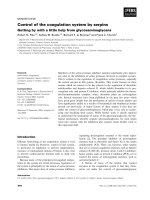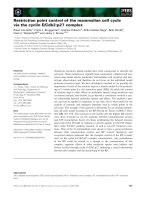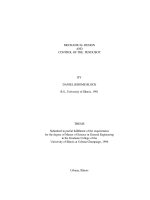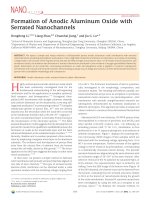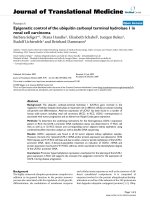- Trang chủ >>
- Khoa Học Tự Nhiên >>
- Vật lý
control of the anodic aluminum oxide barrier layer opening
Bạn đang xem bản rút gọn của tài liệu. Xem và tải ngay bản đầy đủ của tài liệu tại đây (546.09 KB, 5 trang )
Control of the Anodic Aluminum Oxide Barrier Layer Opening
Process by Wet Chemical Etching
Catherine Y. Han,
†,‡
Gerold A. Willing,
†,§
Zhili Xiao,
|
and H. Hau Wang*
Materials Science DiVision, Argonne National Laboratory, Argonne, Illinois 60439
ReceiVed January 19, 2006. In Final Form: October 18, 2006
In this work, it has been shown that, through a highly controlled process, the chemical etching of the anodic
aluminum oxide membrane barrier layer can be performed in such a way as to achieve nanometer-scale control of
the pore opening. As the barrier layer is etched away, subtle differences revealed through AFM phase imaging in the
alumina composition in the barrier layer give rise to a unique pattern of hexagonal walls surrounding each of the barrier
layer domes. These nanostructures observed in both topography and phase images can be understood as differences
in the oxalate anion contaminated alumina versus pure alumina. This information bears significant implication for
catalysis, template synthesis, and chemical sensing applications. From the pore opening etching studies, the etching
rate of the barrier layer (1.3 nm/min) is higher than that of the inner cell wall (0.93 nm/min), both of which are higher
than the etching rate of pure alumina layer (0.5-0.17 nm/min). The established etching rates together with the etching
temperature allow one to control the pore diameter systematically from 10 to 95 nm.
Introduction
Porous anodic aluminum oxide (AAO) membranes have
attracted significant interest during recent years due to the fact
that they are readily synthesized through a simple procedure and
extremely useful innanosciencestudies.Porediameter(10-300
nm) and pore-pore distance (25-500 nm) can be controlled
over a narrow distribution range through proper selection of the
type and concentration of electrolyte, applied anodization
potential,andtemperature.
1-4
Highlyordered,straightnanopores
in hexagonally close-packed arrays with domain sizes of
approximately 2.5 × 2.5 µm
2
and aspect ratios as high as 1000
can be readily achieved. The pore-pore distance and barrier
oxide layer thickness are mainly determined by the applied
anodization potential, while the electrolyte pH determines the
dissolution rate of aluminum oxide, which directly affects the
resulting pore diameter.
The nanopores within the AAO membranes can be used as
templatesforfabricatingvariousnanoscalestructures.Nanowires
of a variety of materials, including Ni,
5
Bi,
6
Au,
7-9
Ag,
10
Co,
11
ZnO,
12
Fe,
13
and Sb
14
with diameters of 60-200 nm, have been
fabricated by electrodeposition into the nanopores. Carbon
nanotubes
15
and boron nanowires
16
have been created in the
AAO nanopores by utilizing a chemical vapor deposition
technique.Highlyorderedantidot arrays havealsobeen produced
by coating the surfaces of porous AAO membranes with
magnetic
17
or superconducting
18
materials.
A hemispherical shell with homogeneous thickness known as
the barrierlayerdevelopsat the bottom of everynanoporeduring
theanodizationprocess. Todate,this barrierlayerhas notattracted
much attention in the literature, even though many applications
require itsremovaltocreate through-hole membranes. Examples
for such applications include energy-efficient gas separation and
pattern-transfer masks for e-beam evaporation,
19
reactive ion
etching,
20
or molecular-beam epitaxial growth.
21
Through a
carefully controlled barrier layer etching process, one can
systematically prepare a tunable pore opening. Three methods
had been used to open the barrier oxide layer: wet chemical
etching,
1-3
ion milling,
22
and plasma etching.
20
Of these, the wet
etching has been regarded as difficult to control and only ion
milling has received more detailed analysis in the literature.
22
Both ion milling and plasma etching have the advantage of
maintaining intact pores after barrier layer removal, but require
expensive equipment, and a typical setup allows only a small
area around 1 × 1mm
2
to be removed at any given time and,
thus, they are cost- and time-intensive. Wet chemical etching,
when properly controlled, can be used to etch samples with large
dimensions (for example, 2 × 2cm
2
) and is fast, convenient,
inexpensive, and reliable. It has been used routinely in our
laboratory for opening the barrier layers of AAO membranes.
* To whom correspondence should be addressed. E-mail: hau.wang@
anl.gov.
†
Equal contribution.
‡
Current address: R.J. Daley College, Chicago, IL.
§
Current address: Department of Chemical Engineering, University of
Louisville, Louisville, KY.
|
Current address: Department of Physics, Northern Illinois University,
DeKalb, IL, and ANL/MSD.
(1) Masuda H.; Satoh, M. Jpn. J. Appl. Phys. 1996, 35, L126.
(2) Masuda, H.; Hasegwa, F.; Ono, S. J. Electrochem. Soc. 1997, 144, L127.
(3) Masuda, H.; Yada, K.; Osaka, A. Jpn. J. Appl. Phys. 1998, 37, L1340.
(4) Li, A. P.; Mu¨ller, F.; Birner, A.; Nielsch, K.; Go¨sele, U. J. Appl. Phys.
1998, 84, 6023.
(5) Nielsch, K.; Muller, F.; Li, A.; Gosele U. AdV. Mater. 2000, 12 (8), 582.
(6) Wang, X. F.; Zhang, L. D.; Zhang, J.; Shi, H. Z.; Peng, X. S.; Zheng, M.
J.; Fang, J.; Chen, J. L.; Gao, B. J. J. Phys. D: Appl. Phys. 2001, 34, 418.
(7) Wang, Z.; Su, Y. K.; Li, H. L. Appl. Phys. A 2002, 74, 563.
(8) Brumlik, C. J.; Menon, V. P.; Martin, C. R. J. Mater. Res. 1994, 9 (5),
1174.
(9) Foss, C. A., Jr.; Hornyak, G. L.; Stockert, J. A.; Martin, C. R. J. Phys.
Chem. 1994, 98, 2963.
(10) Sauer, G.; Brehm, G.; Schneider, S.; Nielsch, K.; Wehrspohn, R. B.;
Choi, J.; Hofmeister, H.; Gosele, U. J. Appl. Phys. 2002, 91 (5), 3243.
(11) Zeng, H.; Zheng, M.; Skomki, R.; Sellmyer, J.; Liu, Y.; Menon, L.;
Bandyopadhyay, S. J. Appl. Phys. 2000, 87 (9), 4718.
(12) Li, Y.; Meng, G. W.; Zhang, L. D. Appl. Phys. Lett. 2000, 76 (15),
2011.
(13) Li, F.; Metzger, R.; Doyle, W. D. IEEE Trans. Magn. 1997, 33 (5), 3715.
(14) Zhang, Y.; Li, G.; Wu, Y.; Zhang, B.; Song, W.; Zhang, L. AdV. Mater.
2002, 14 (17), 1227.
(15) Li, J.;Papadopoulos, C.; Xu, J. M.; Moskovits, M. Appl. Phys. Lett. 1999,
75 (3), 367.
(16) Yang, Q.; Sha, J.; Xu, J.; Ji, Y.J.; Ma, X. Y.; Niu,J. J.; Hua, H. Q.; Yang,
D. R. Chem. Phys. Lett. 2003, 379, 87.
(17) Xiao, Z. L.; Han, C. Y.; Welp, U.; Wang, H. H.; Vlasko-Vlasov, V. K.;
Kwok, W. K.; Miller, D. J.; Hiller, J. M.; Cook, R. E.; Willing, G. A.; Crabtree,
G. W. Appl. Phys. Lett. 2002, 81, 2869.
(18) Crabtree, G. W.; Welp, U.; Xiao, Z. L.; Jiang, J. S.; Vlasko-Vlasov, V.
K.; Bader, S. D.; Liang, J.; Chik, H.; Xu, J. M. Physica C 2003, 387, 49.
(19) Masuda, H.; Yasui, K.; Nishio, K. AdV. Mater. 2000, 12 (14), 1031.
(20) Liang, J.; Chik, H.; Yin, A.; Xu, J. J. Appl. Phys. 2002, 91, 2544.
(21) Mei, X.; Kim, D.; Ruda, H. E.; Guo, Q. X. Appl. Phys. Lett. 2002, 81,
361.
(22) Xu, T.; Zangari, G.; Metzger, R. M. Nano Lett. 2002, 2, 37.
1564 Langmuir 2007, 23, 1564-1568
10.1021/la060190c CCC: $37.00 © 2007 American Chemical Society
Published on Web 12/19/2006
While there seems to be a number of researchers utilizing
chemical etchingforopeningthe barrier layer, verylittledetailed
study hasbeenmade in the pasttoreveal the barrier layeropening
process. As such, there is a lack of knowledge concerning the
dynamics of this process. The most common remark upon this
process that can be found in the literature is “ the barrier layer
is removedin5%H
3
PO
4
at 30°Cfor60 min.”
1
Our experimental
results show that if the chemical etching is done with proper
control, 10-95 nm openings in the barrier layer can be obtained
systematically for AAO membranes made in oxalic acid. In
addition, very interesting double hexagon nanostructures were
observedforthefirst timethroughAFMimaging beforecomplete
removal of the barrier layer. These nanostructures reveal the
impurity distribution in the membranes that bear significant
implication for catalysis and sensing applications.
Experimental Section
Anodic aluminum oxide (AAO) membranes with hexagonally
ordered arraysof nanopores wereprepared byatwo-step anodization
procedure as described previously.
1
Aluminum sheets (Alfa Aesar,
99.998% pure, 0.5 mm thick) were degreased in acetone and then
annealed at 500 °Cfor4 h under an argon atmosphere. TheAlsheets
were then electropolished in a solution of HClO
4
and ethanol (1:8,
v/v) at a current density of 200 mA/cm
2
for 10 min or until a mirror-
like surface smoothness was achieved.
The first anodization step was carried out in a 0.3 M oxalic acid
solution at 3 °C for 24 h. The 70 µm thick porous alumina layer was
then stripped away from the Al substrate by etching the sample in
a solution containing 6 wt % phosphoric acid and 1.8 wt % chromic
acid at 60 °C for 12 h. This step not only removes the disordered
AAO membrane but also leaves a highly ordered dimple array on
the aluminum surface. Each dimple initiates new pore formation
during the second anodization step, which was carried out under the
same conditions as the first step. A freestanding AAO membrane
with highly ordered arrays of nanopores was then obtained by
selectively etching away the unreacted Al in a saturated HgCl
2
solution.
A U-shapedaluminum oxidelayeror barrierlayerwith athickness
of 30-40 nm forms at the bottom of every nanopore during
anodization. A protective polymer layer made of a mixture of
nitrocellulose and polyester resin was coated on the top surface of
the AAO membrane that is opposite to the barrier layer to prevent
overetching of the surface structure and uneven diffusion of acid
into the nanopores.
26
The membrane was then immersed in 200 mL
of 5.00wt% phosphoric acidat30.0 °C fordifferentperiods of time,
rinsed with distilled water, and dried under ambient conditions. The
barrier layer removal and pore widening process was then studied
with use of AFM (Digital Instruments, Dimension 3000 with a type
IIIa controller and TESP Si cantilevers) and SEM (Hitachi S-4700-
II). Effective pore diameters were determined by analyzing the total
pore area of each image using Scion Image based on NIH Image
to ascertain the average area per pore and, hence, the average pore
diameter.
Results and Discussion
The model of an AAO nanopore is shown in Figure 1 by
following a literature reference.
25
As indicated in the figure, C
is the cell dimension (pore-to-pore distance) with cell wall
thicknessw,Pisthepore diameter,andA isthecenter of curvature
that moves continuously during anodization toward the bottom.
The active layer during nanopore growth is the barrier layer with
thickness (d). There are two active interfaces associated with the
barrier layer. The outer one is associated with oxidation of
aluminum to aluminum cation (Al f Al
3+
), and the inner one
is associated with O
2-
migration that leads to the formation of
alumina (Al
2
O
3
), aswellas dissolution and depositionofalumina
to and from the etching solution. The whole process is driven
by the local electric field (E), which is defined by the current
applied (I) over conductivity (σ) and the surface area of the
spherical bottom (ω/4π × 4πb
2
) ωb
2
where ω is the solid angle
of the active barrier area and b radius of curvature).
Under a constant applied potential and during equilibrium
growth, each nanoporewillreachanoptimized solid angle ω and
radiusofcurvatureb, whichwilllead to aconsistentpore diameter
and result in a two-dimensional hexagonally close-packed pore
array.
AAO Barrier Layer Opening This study utilizes a freestand-
ing AAO film with a protective polymer layer made of a mixture
of nitrocellulose and polyester resin on the porous side of the
film.
26
The polymer layer is used to block the pores and thus
prevent uneven etching of the AAO barrier layer from inside,
which may be caused by the uneven acid diffusion through the
AAO pores. The presence of the protective layer also focuses
the etching process on the bottom side of the barrier layer, which
iscomprisedof a hexagonallyclosepacked arrayofhemispherical
domes that are 120 nm in diameter and 27 nm in height (Figure
2a). The domes begin to shrink both in diameter and height once
the etching process starts. After 18 min of etching, the domes
have decreased in size to approximately 100 nm in diameter and
24 nm in height (Figure 2b). It is interesting to note that, at this
early stage of the etching process, the walls of each individual
cell are becoming more pronounced, which suggests that the
area in-between individual domes is not etched as quickly as the
domesthemselves.This trendcontinuesthrough 30 minofetching
with the domes continuing to decrease in size (85 nm in diam-
eter and 16 nm in height) and the hexagonal cell walls be-
coming clearly visible to form a double hexagon nanostructure
(Figure 2c).
After 40 min of etching, the barrier layer is finally breached
by the acid (Figure 2d). Note that the initial opening is uneven
across the surface. The majority of the cells have an opening of
∼10 nm, while some of the cells remain closed. While the
aluminum surface used to create the AAO membrane was
annealed andelectropolishedbeforeanodization, the surface still
maintainsacertaindegree ofroughness.This roughnesstranslates
into a subtle variation in the thickness of the barrier layer.
23
Those domes that are thinnerwouldobviouslybeetchedthrough
earlier. It should also be noted that the walls of each individual
(23) Masuda, H.; Abe, A.; Nakao, M.; Yokoo, A.; Tamamura, T.; Nishio, K.
AdV. Mater. 2003, 15 (2), 161.
(24) Zhou, B.; Ramirez, W. F. J. Electrochem. Soc. 1996, 143, 619.
(25) O’Sullivan J. P.; Wood, G. C. Proc. R. Soc. London A 1970, 317, 511.
(26) Xu, T. T.; Piner, R. D.; Ruoff, R. S. Langmuir 2003, 19, 1443.
Figure 1. Schematic drawing of the cross section of a nanopore.
E )
J
σ
)
I
σωb
2
Control of the AAO Barrier Layer Opening Process Langmuir, Vol. 23, No. 3, 2007 1565
cell have become distinct enough to completely encircle each
dome. Oncethedomes have been breachedinitially,the openings
begin to widen to generate a unique surface topography which
combines a hexagonal cell wall surrounding each opened dome.
This process can be used to create membranes with a wide range
of pore diameters with fixed pore-to-pore distance, from sub-10
nm, to 34 nm, to 48 nm, and to 70 nm just by terminating the
etching process at 40, 50, 60, and 70 min, respectively (Figures
2d-2f and Figure 3a). The pronounced hexagonal walls persist
through the entire procedure, even after the barrier layer has
been completely removed at 70 min of etching.
Ascanbe seenfromthe images,thepores becomemorecircular
as etching progresses. This is similar to other techniques, like
ion milling, where the pore shape is fairly circular at larger pore
diameters (ca. 45 nm) but some distortion is still observed.
22
While these images may represent the true shape of the hole,
especially at the smaller diameters, there is also the possibility
that there is a convolution between the AFM tip and hole that
is distorting the image. We suspect that this is partially the case
as there were some changes in the image depending on the scan
direction, which is a clear indication that tip shape is affecting
the image. Even if this is the case though, these results suggest
that applications that require a very uniform shape should utilize
membranes that have been etched for longer periods of time to
ensure a more uniform pore shape.
Two Regions of Different Etching Rates Figure 4 shows the
rate of pore opening as a plot of pore diameter with respect to
time measuredbyAFM(O) and SEM (b)imaging.Theeffective
diameter at each time step is obtained from the average pore area
measured over a large number of pores across several sample
membranes. Note that the two techniques give fairly consistent
results, especially before the complete removal of the barrier
layer. From 40 to 90 min of etching, the pore opening rate is
about 1.3 nm/min, but the following pore expansion rate is much
slower, at about 0.5 nm/min. A variation in the diffusion rate of
acid across the surface can be ruled out as a cause of this etching
rate difference as there is very little height variation initially
from the top of the dome to the bottom of the crevice, as can
be seen in Figure 5a. This means the barrier layer must consist
of materials that are more susceptible to chemical etching than
the materials building the inner cell wall of the AAO pore. We
attribute this to the fact that the barrier layer is the growth front
of the anodization process;
25
it is constantly building up and
redissolving. This action allows the oxalate anion (Ox), C
2
O
4
2-
,
and H
2
O to be mixed with the alumina within the barrier layer,
leading to a less dense composite material, Al
2
O
3
mixed with
Al
2
(Ox)
3
.
To further verify that there is a material difference between
thedomesandthe cellwalls,we carried outanetching experiment
onthefrontside ofanAAO membraneunderthesame conditions.
Figure2. Stages ofchemicaletchingprocessof theanodic aluminum
oxide barrier layer. Etching progress after (a) 0 min, (b) 18 min, (c)
30 min, (d) 40 min, (e) 50 min, and (f) 60 min.
Figure3. AFM topographyandphaseimagesof theAAO membrane
after (a and b) 70 min and (c and d) 90 min of etching.
Figure 4. Etching of the barrier side (b, SEM; O, AFM) and front
side (/, SEM) of AAO membranes in 5.00 wt % H
3
PO
4
at 30.0 °C.
1566 Langmuir, Vol. 23, No. 3, 2007 Han et al.
The results, as seen in Figure 4 (*, measured by SEM), show that
there are also two differentregimes.Thefirstregime,whichruns
from 10 to 60 min, shows the pore diameter increasing at a rate
of 0.93 nm/min, which means the cell walls are etched at a
slower rate than the domes of the barrier layer (1.3 nm/min). As
can be seen from Figure 4, the change in diameter versus time
is fairly linear. The second regime, which begins at 60 min, has
an etching rate of only 0.17 nm/min. The two different etching
ratesclearlyindicate thatthecell walliscomprised oftwodifferent
material layers. EarlierstudiesofAAOhave suggested that there
is a measurable difference in the alumina of these two areas
arising from the entrapment of conjugated base anions in the
aluminanearthepore.
27
Duringourrecentqualitative UV-Raman
studies pure alumina powders, AAO membrane prepared from
oxalic acid, and commercial dehydrated aluminum oxalate were
compared.
28
While pure amorphous alumina gave no Raman
band in the 600-1900 cm
-1
region, the AAO membrane and
Al
2
(Ox)
3
revealed nearlythesameUV-Raman spectra. Theinner
layer consists of oxalate C
2
O
4
2-
anion contaminated alumina
while the outer layer consists of relatively pure alumina.
27
The
ion mobility, µ, is the limiting velocity of an ion (υ) in an electric
field (E) of unit strength. The force from the field to the ion is
|z|eE which is balanced by the frictional drag that can be
approximated by Stokes law, 6πηrυ, where z is the charge on
the ion, e the electronic charge, η the viscosity of the medium,
and r the radius of the ion.
29
Combining the two formulas gives
The mobility ratio of oxygen anion to oxalate anion can be
estimated from their radii: µ
O
2-
/µ
C
2
O
4
2-
) r
C
2
O
4
2-
/r
O
2-
∼ 1.8.
Therefore, only the inner layer of the cell wall is contaminated
with the oxalate anions due to their much slower mobility and
it is reasonable that the anion contaminated alumina is easier to
be etched away by H
3
PO
4
than the purer alumina, as shown by
our etching rate studies.
Underlying StructureandImpurity Distribution. Knowing
about the presence of pure alumina and oxalate contaminated
alumina and identifying two different etching rates, the double
hexagon nanostructures observed between 18 min (Figure 2b)
and 60 min (Figure 2f) etching time can now be analyzed in
more detail. These unique nanostructures can only be observed
during this ∼40 min window and have never been reported
previously. Figures 5a and 5b show the section analyses of the
AAO membranes just before (30 min etching) and after (50 min)
the barrier layer was breached, respectively. The double-dip
features with 25 nm separation and 2.5 nm height at the 30 min
etching (Figure 5a) and 31 nm separation and 2.9 nm height at
the 50 min etching (marked in Figure 5b) are clearly observed
inbothfiguresand indicatetheboundary of purealuminabetween
the cells as depicted schematically in Figure 5c. In addition, the
two types of alumina as indicated in the cell wall of Figure 5c
can be observed from the AFM phase imaging technique, which
is sensitive to changes in elastic modulus and surface hardness
of the AAO membrane. The cell wall nanostructures can be
observedfromboth topography(Figure2c-2f)andphaseimaging
(not shown here). At the early etching stage (18 min, Figure 2b)
and just after the barrier layer has been removed (70 min, Figure
3a), while topography imaging simply showed the actual cell
size andshape,phaseimaging continued to reveal theunderlying
cell wall nanostructures. As shown in pseudo color (Figure 3b,
70 min), the contaminated alumina is indicated with light blue
next to the dark blue pore, while the pure alumina of the cell
wall, which is harder than the alumina near the pore, is indicated
as pink. As the pores are etched further (90 min etching, Figure
3c), this contaminated layer is quickly removed, leaving behind
only the pure alumina wall indicated as blue walls in Figure 3d
and empty pores in green.
Implications of the Barrier Layer. If the barrier layer was
made of concentric layers of the same material throughout the
whole curvature, the whole barrier layer should be etched away
all at once under homogeneous etching without diffusion limit,
which is not supported by the aforementioned observation. It is
quite obvious from Figure 2d-2f that the barrier layer is first
breached at the very top or center of the domes, and then the
small opening is gradually enlarged and eventually the whole
(27) Thompson, G. E.; Wood, G. C. Nature 1981, 290, 230.
(28) Xiong, G.; Elam, J. W.; Feng, H.; Han, C. Y.; Wang, H. H; Iton, L. E.;
Curtiss, L. A; Pellin, M. J.; Kung, M.; Kung, H.; Stair, P. C. J. Phys. Chem. B
2005, 109, 14059.
(29) Bard, A. J.; Faulkner, L. R. Electrochemical Methods Fundamentals and
Applications; John Wiley & Sons: New York, 1980; p 65.
Figure 5. (a) Section analysis of AAO membrane at30minetching
(same sample as Figure 2c) showing a cross section of the barrier
layer and the double-dip feature. (b) Section analysis of AAO
membrane at 50 min etching (same as Figure 2e) showing the
collapsed domeand thedouble-dipfeature (markedwithred arrows).
(c) Schematic drawing of the bilayered cell wall (gray area, oxalate
contaminatedalumina;white, purealumina),the barrierlayer (shown
with thicker oxalate contaminated layer), and the double-dip feature
observed during etching.
µ )
υ
E
)
|z|e
6πηr
) A
|z|
r
Control of the AAO Barrier Layer Opening Process Langmuir, Vol. 23, No. 3, 2007 1567
dome is etched away as the chemical etching process proceeds.
Based on our etching results, the barrier layer cannot consist of
simple concentric layers with different purity. The barrier layer
is more complex than the composition of the bilayer cell wall.
From the breaching pattern, the impure inner layer is thicker
around the center of each barrier layer. This is possibly due to
the factthatanodizationis a dynamic process. Sincetheeffective
centerofcurvatureis continuously movingforwardduring anodi-
zation, the center area of each cell barrier always remains redox
active while the boundary between the bottom barrier and cell
wallisgradually becoming redoxinactive.There aretworesulting
effects from this transition. First, the barrier layer will contain
more oxalate anions than that of the cell wall as evidenced by
the faster etching rate (Figure4barriervsfrontetching).Second,
while migration of the oxalate anions driven by an electric field
will stop after the boundary area becomes inactive, diffusion of
oxalate from the barrier layer to the cell wall due to higher con-
centration will continue. This process would leave the boundary
of the barrier with a lower oxalate concentration and the center
of the barrierlayeraslightlyhigher oxalate concentration. While
this hypothesis explains the phenomenological observation of a
pore opening, quantitative explanation must rely on detailed
theoretical simulation which is beyond the scope of this study.
TemperatureDependencyofthe Etching Rate.The reaction
rates before and after the breaching of the barrier layer were
measured at four different temperatures (20, 25, 30, and 35 °C)
in 5.00 wt % H
3
PO
4
. Assuming that the rate constant, k, obeys
the Arrhenius temperature dependence, the rate (r) leads to
This equation assumes that the reaction rate is first order with
respect to the hydrogen ion concentration. While this would not
seem obvious from the equation for the etching reaction,
prior work has shown that the rate law is first-order.
24
Plotting
ln r versus 1/T (Figure 6) gives the relationship of reaction rate
and etching temperature as
Theactivationenergyfor etchingbeforeporeopening is∼20%
higher and the correlations can be used to calculate the reaction
rate at any given temperature and thus can be used to predict the
approximate etching time to achieve a desired pore diameter.
Demonstration as a Nanomask. AAO membranes with
various pore diameters are useful for mask applications. As a
simple demonstration, we prepared a thin AAO membrane (750
nm thick) with the pore (90 nm) completely open and placed the
AAO mask over a Si wafer. Through thermal evaporation, a 50
nm Au thin film was deposited on the AAO membrane. The
alumina membrane was then removed with chemical etching
and the resulting 50 nm Au nanodot array on Si is shown in
Figure 7. These Au nanodots are deposited in a hexagonally
close-packed pattern exactly mirroring the AAO pore arrange-
ment. The whole process, which demonstrates the proof of
concept, was carried out in a wet chemistry lab setting and no
lithographic tools were required. The missing regions of dots are
most likely due to the fact that the masking process has not been
optimized and as such, some areas of the gold did not fully
adhere to the Si substrate prior to removal of the AAO mask.
Further studies into the masking process should improve the
yieldanduniformityof the nanodotarray.These metallic nanodot
arrayscanbeused in thefuturefor chemical sensingandlocalized
surface plasmon resonance Raman enhancement studies.
Summary
In thiswork,it has been shownthatthrough a highly controlled
process the chemical etching of the AAO barrier layer can be
performed in such a way as to achieve nanometer scale control
of the pore opening. Such control can be extremely useful in
membrane technologyandlithographicmask applications. Also,
as the barrier layer is etched away, subtle differences revealed
through AFM phase imaging in the alumina composition in the
barrier layer give rise to a unique pattern of hexagonal walls
surrounding each of the barrier layer domes. In addition, the
oxalate anion contaminated alumina and pure alumina in these
membranes have been directly imaged with AFM techniques.
Thisinformationbearssignificant implicationforfuture catalysis,
template synthesis, and chemical sensing applications.
Acknowledgment. Workat Argonne National Laboratory is
sponsored by the U.S. Department of Energy, Office of Basic
Energy Science, Division of Materials Science, under Contract
W-31-109-ENG-38. C.Y.H. and H.H.W. acknowledge the use
of the ANL/EMC facility. G.A.W. and H.H.W. acknowledge the
use of the ANL/MSD AFM facility.
LA060190C
Figure 6. Reaction rates before (O) and after (b) breaching of the
barrier layer at four different temperatures (20, 25, 30, and 35 °C).
r ) Ae
-E/RT
[H
+
]
Al
2
O
3
+ 6H
+
f 2Al
3+
+ 3H
2
O
ln r
before
)-9600 × (1/T) + 32 (R
2
) 0.9963)
ln r
after
)-8000 × (1/T) + 27 (R
2
) 0.963)
Figure 7. SEM image of a Au nanodot array on a silicon wafer (90
nm dot diameter and 125 nm dot-to-dot distance). The missing Au
dots may be the results of pore blockage or loss during the mask
lift-off process.
1568 Langmuir, Vol. 23, No. 3, 2007 Han et al.

